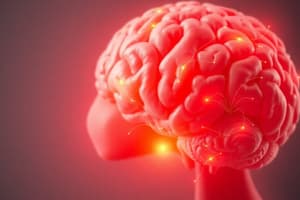Podcast
Questions and Answers
What is the primary effect of dopaminergic action in the striatum?
What is the primary effect of dopaminergic action in the striatum?
- It increases acetylcholine levels in the motor cortex.
- It promotes excitatory feedback to the spinal motor neurons.
- It exerts excitatory influence on SN-PR and GP-I.
- It exerts inhibitory influence on SN-PR and GP-I. (correct)
How does levodopa bioavailability get affected according to the provided information?
How does levodopa bioavailability get affected according to the provided information?
- It is influenced by the type of amino acids ingested. (correct)
- It is unaffected by the presence of food.
- It is only dependent on the rate of gastric emptying. (correct)
- It is determined solely by first-pass metabolism rates.
What is observed about prolactin levels during levodopa therapy in Parkinson's patients?
What is observed about prolactin levels during levodopa therapy in Parkinson's patients?
- Prolactin levels decrease. (correct)
- Prolactin levels fluctuate significantly.
- Prolactin levels consistently increase.
- Prolactin levels remain unchanged.
What might happen if gastric emptying is slow during levodopa therapy?
What might happen if gastric emptying is slow during levodopa therapy?
What side effect commonly occurs in patients receiving levodopa therapy?
What side effect commonly occurs in patients receiving levodopa therapy?
What is the primary effect of combining levodopa with carbidopa or benserazide?
What is the primary effect of combining levodopa with carbidopa or benserazide?
Which of the following conditions requires cautious use of levodopa?
Which of the following conditions requires cautious use of levodopa?
What consequence does pyridoxine have when combined with levodopa that is not combined with carbidopa?
What consequence does pyridoxine have when combined with levodopa that is not combined with carbidopa?
What is the usual daily dose of levodopa for therapeutic effect?
What is the usual daily dose of levodopa for therapeutic effect?
Which of the following is a characteristic of decarboxylase inhibitors like carbidopa and benserazide?
Which of the following is a characteristic of decarboxylase inhibitors like carbidopa and benserazide?
What does the degeneration of neurones in the substantia nigra pars compacta primarily lead to in Parkinson's disease?
What does the degeneration of neurones in the substantia nigra pars compacta primarily lead to in Parkinson's disease?
Which of the following is a common cause of drug-induced temporary parkinsonism?
Which of the following is a common cause of drug-induced temporary parkinsonism?
What major breakthrough in treatment for Parkinson’s disease occurred in 1967?
What major breakthrough in treatment for Parkinson’s disease occurred in 1967?
What is a likely consequence of excessive excitatory transmitter glutamate in Parkinson’s disease?
What is a likely consequence of excessive excitatory transmitter glutamate in Parkinson’s disease?
Which type of Parkinsonism is most likely to be idiopathic?
Which type of Parkinsonism is most likely to be idiopathic?
What is one of the common side effects associated with high doses of bromocriptine in patients?
What is one of the common side effects associated with high doses of bromocriptine in patients?
What is the purpose of combining levodopa with a decarboxylase inhibitor in treatment?
What is the purpose of combining levodopa with a decarboxylase inhibitor in treatment?
What is the initial dose of bromocriptine recommended for patients?
What is the initial dose of bromocriptine recommended for patients?
Which of the following is a side effect that may occur early in patients taking bromocriptine?
Which of the following is a side effect that may occur early in patients taking bromocriptine?
How do the newer D2/D3 receptor agonists like ropinirole and pramipexole compare to bromocriptine?
How do the newer D2/D3 receptor agonists like ropinirole and pramipexole compare to bromocriptine?
What is a consequence of progressive degeneration of peripheral decarboxylase DA neurons?
What is a consequence of progressive degeneration of peripheral decarboxylase DA neurons?
How does the combination of carbidopa and levodopa affect treatment outcomes in Parkinson's disease?
How does the combination of carbidopa and levodopa affect treatment outcomes in Parkinson's disease?
Which factor is important to consider when administering levodopa to elderly patients?
Which factor is important to consider when administering levodopa to elderly patients?
What characteristic of pyridoxine impacts the effectiveness of levodopa when not combined with carbidopa?
What characteristic of pyridoxine impacts the effectiveness of levodopa when not combined with carbidopa?
What is the usual starting dose of levodopa for effective therapy?
What is the usual starting dose of levodopa for effective therapy?
What is the usual daily maintenance dose of levodopa?
What is the usual daily maintenance dose of levodopa?
Which of the following statements about ropinirole is correct?
Which of the following statements about ropinirole is correct?
What can be said about the side effect profile of bromocriptine compared to pramipexole?
What can be said about the side effect profile of bromocriptine compared to pramipexole?
In the treatment of advanced PD, what is a common characteristic regarding the capacity to synthesize DA?
In the treatment of advanced PD, what is a common characteristic regarding the capacity to synthesize DA?
What is the significance of dose titration for maximum improvement in PD therapy?
What is the significance of dose titration for maximum improvement in PD therapy?
Flashcards
Hypokinesia
Hypokinesia
Reduction in the ability to initiate and execute voluntary movements, seen in Parkinson's disease.
Rigidity
Rigidity
Increased muscle tone, a symptom of Parkinson's disease.
Tremor
Tremor
Involuntary rhythmic shaking or tremor, a hallmark sign of Parkinson's disease.
Metabolism
Metabolism
Signup and view all the flashcards
First Pass Metabolism
First Pass Metabolism
Signup and view all the flashcards
What is the 'on-off' effect in Parkinson's?
What is the 'on-off' effect in Parkinson's?
Signup and view all the flashcards
How does Levodopa work?
How does Levodopa work?
Signup and view all the flashcards
What are peripheral decarboxylase inhibitors?
What are peripheral decarboxylase inhibitors?
Signup and view all the flashcards
Why is Pyridoxine (Vitamin B6) not used with Levodopa?
Why is Pyridoxine (Vitamin B6) not used with Levodopa?
Signup and view all the flashcards
What happens to the half-life of Levodopa with peripheral decarboxylase inhibitors?
What happens to the half-life of Levodopa with peripheral decarboxylase inhibitors?
Signup and view all the flashcards
Parkinson's Disease (PD)
Parkinson's Disease (PD)
Signup and view all the flashcards
What is the main pathological change in PD?
What is the main pathological change in PD?
Signup and view all the flashcards
What is 'excitotoxicity'?
What is 'excitotoxicity'?
Signup and view all the flashcards
What is drug-induced Parkinsonism ?
What is drug-induced Parkinsonism ?
Signup and view all the flashcards
What is levodopa?
What is levodopa?
Signup and view all the flashcards
What are dopamine agonists?
What are dopamine agonists?
Signup and view all the flashcards
Why are dopamine agonists useful for early Parkinson's?
Why are dopamine agonists useful for early Parkinson's?
Signup and view all the flashcards
What makes pramipexole different?
What makes pramipexole different?
Signup and view all the flashcards
What are the advantages of pramipexole over bromocriptine?
What are the advantages of pramipexole over bromocriptine?
Signup and view all the flashcards
How can dopamine agonists help in advanced Parkinson's?
How can dopamine agonists help in advanced Parkinson's?
Signup and view all the flashcards
What is the standard approach for treating Parkinson's disease, and when is it not used?
What is the standard approach for treating Parkinson's disease, and when is it not used?
Signup and view all the flashcards
What is "co-careldopa"?
What is "co-careldopa"?
Signup and view all the flashcards
What are ropinirole and pramipexole?
What are ropinirole and pramipexole?
Signup and view all the flashcards
How is bromocriptine used in Parkinson's disease treatment?
How is bromocriptine used in Parkinson's disease treatment?
Signup and view all the flashcards
Why is bromocriptine less commonly used than ropinirole and pramipexole?
Why is bromocriptine less commonly used than ropinirole and pramipexole?
Signup and view all the flashcards
Study Notes
Parkinsonism
- Parkinsonism is an extrapyramidal motor disorder featuring rigidity, tremor, and hypokinesia.
- Secondary symptoms include posture and gait problems, a mask-like face, excessive saliva production, and potentially dementia.
- Untreated, it progresses to a severe stage where patients are rigid, immobile, and susceptible to infections or embolisms.
- Parkinson's disease (PD) is a progressive degenerative disorder mainly affecting the elderly.
- Idiopathic causes account for most cases, while some are attributed to arteriosclerosis.
- Wilson's disease, a rare copper poisoning disorder, is another possible cause.
Neurological Degeneration in PD
- The substantia nigra pars compacta (SN-PC) and the nigrostriatal dopaminergic tract are predominantly affected in PD.
- This leads to dopamine (DA) deficiency in the striatum, contributing to muscle tone imbalances and movement coordination issues.
- A deficiency arises from an imbalance between dopaminergic (inhibitory) and cholinergic (excitatory) systems in the striatum.
- Oxidative stress caused by DA metabolism may trigger neuronal damage.
- Age-related declines in protective mechanisms, environmental toxins, and genetic predispositions exacerbate this vulnerability.
- Mitochondrial dysfunction in aging further exacerbates neuronal damage.
- Exposure to MPTP-like chemicals, present in some drugs, accelerated age-related/pre-disposed neuronal damage contributing to parkinsonism.
- Excess glutamate can induce neuronal death through NMDA receptors.
Treatment Breakthrough and Classification
-
A groundbreaking 1967 discovery demonstrated levodopa's potential to treat PD effectively.
-
Levodopa, the precursor to DA, is significantly effective, but doesn't cross the blood-brain barrier, necessitating its use with other substances.
-
Several types of drugs are crucial in treating parkinsonism.
-
Drugs affecting brain dopaminergic system:
- Dopamine precursor: Levodopa
- Peripheral decarboxylase inhibitors: Carbidopa, Benserazide
- Dopaminergic agonists: Bromocriptine, Ropinirole, Pramipexole
- MAO-B inhibitor: Selegiline, Rasagiline
- COMT inhibitors: Entacapone, Tolcapone
Levodopa Actions
- Levodopa exhibits a highly effective therapeutic effect in Parkinson's disease.
- Although ineffective on its own, it's a precursor to dopamine, enabling its uptake and conversion within the brain.
- Levodopa significantly improves various motor symptoms (e.g., hypokinesia, rigidity, tremor).
- Secondary symptoms like posture, gait, handwriting, speech, facial expression and mood also improve.
- Levodopa can also be used to produce a non-specific "awakening" effect in hepatic coma.
Side Effects of Levodopa
- Common side effects include nausea, vomiting, postural hypotension, and cardiac arrhythmias.
- Development of abnormal movements (dyskinesias) can occur with prolonged use.
- Behavioral effects such as anxiety or psychosis can also manifest.
- Additional side effects include alterations in taste, altered dopamine regulation in the cardiovascular system; or the potential for dopamine to act via excitatory receptors in the vomiting centre leading to nausea and vomiting.
Other Important Drugs in PD Treatment
-
Peripheral Decarboxylase Inhibitors (PDIs): Carbidopa/benserazide are given with levodopa to decrease peripheral metabolism, and hence increase the amount of levodopa available to reach the brain, thereby reducing nausea and vomiting as well as needing a smaller dose of levodopa to give the same effect.
-
Dopamine Agonists (e.g., Bromocriptine, Ropinirole, Pramipexole): These directly stimulate dopamine receptors in the brain, useful as monotherapy in early PD or as an adjunct to levodopa in later stages. These drugs have a slower onset of action compared to levodopa.
-
MAO-B Inhibitors (e.g., Selegiline, Rasagiline): These are helpful in delaying the progression of the disease and reducing the need for higher doses of levodopa, and also reduce the motor fluctuations and 'wearing-off' associated with later-stage disease. They also have a lesser incidence of dyskinesia compared to levodopa.
-
COMT Inhibitors (e.g., Entacapone, Tolcapone): These drugs inhibit the breakdown of levodopa in the periphery, increasing its availability to reach the brain, resulting in the reduction in required doses of levodopa to achieve a therapeutic effect.
-
Anticholinergics (e.g., Trihexyphenidyl, Biperiden): These drugs counter the effects of excess acetylcholine, improving tremors, rigidity and other symptoms in early and milder cases of the disease.
-
Glutamate Antagonists (Amantadine): Less effective than levodopa, amantadine acts on the NMDA receptor (and also has some dopamine facilitator properties), may be supplemented to levodopa in more advanced cases/ patients with dyskinesias.
Studying That Suits You
Use AI to generate personalized quizzes and flashcards to suit your learning preferences.




